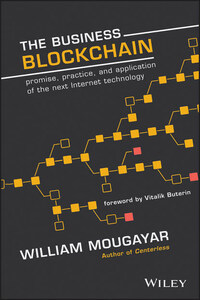Cover and book design: THE FRONTISPIECE
Copyright © 2016 by William Mougayar. All rights reserved.
Published by John Wiley & Sons, Inc., Hoboken, New Jersey.
Published simultaneously in Canada.
No part of this publication may be reproduced, stored in a retrieval system, or transmitted in any form or by any means, electronic, mechanical, photocopying, recording, scanning, or otherwise, except as permitted under Section 107 or 108 of the 1976 United States Copyright Act, without either the prior written permission of the Publisher, or authorization through payment of the appropriate per-copy fee to the Copyright Clearance Center, Inc., 222 Rosewood Drive, Danvers, MA 01923, (978) 750-8400, fax (978) 646-8600, or on the Web at www.copyright.com. Requests to the Publisher for permission should be addressed to the Permissions Department, John Wiley & Sons, Inc., 111 River Street, Hoboken, NJ 07030, (201) 748-6011, fax (201) 748-6008, or online at http://www.wiley.com/go/permissions.
Limit of Liability/Disclaimer of Warranty: While the publisher and author have used their best efforts in preparing this book, they make no representations or warranties with respect to the accuracy or completeness of the contents of this book and specifically disclaim any implied warranties of merchantability or fitness for a particular purpose. No warranty may be created or extended by sales representatives or written sales materials. The advice and strategies contained herein may not be suitable for your situation. You should consult with a professional where appropriate. Neither the publisher nor author shall be liable for any loss of profit or any other commercial damages, including but not limited to special, incidental, consequential, or other damages.
For general information on our other products and services or for technical support, please contact our Customer Care Department within the United States at (800) 762-2974, outside the United States at (317) 572-3993 or fax (317) 572-4002.
Wiley publishes in a variety of print and electronic formats and by print-on-demand. Some material included with standard print versions of this book may not be included in e-books or in print-on-demand. If this book refers to media such as a cd or dvd that is not included in the version you purchased, you may download this material at http://booksupport.wiley.com. For more information about Wiley products, visit www.wiley.com".
ISBN 978-1-119-30031-1 (cloth)
ISBN 978-1-119-30032-8 (ePDF)
ISBN 978-1-119-30033-5 (ePub)
For my parents, who continue to be by my side
To Maureen, with whom everything is possible
And to our beloved dog, Pasha, the brave little Bichon Frisé
You filled my heart forever
THIS DECADE IS AN INTERESTING time for the development of decentralized technologies. Although cryptographers, mathematicians and coders have been working on increasingly specific and advanced protocols in order to get stronger and stronger privacy and authenticity guarantees out of various systems – from electronic cash to voting to file transfer – progress was slow for over 30 years. The innovation of the blockchain – or, more generally, the innovation of public economic consensus by Satoshi Nakamoto in 2009 – proved to be the one missing piece of the puzzle that single-handedly gave the industry its next giant leap forward.
The political environment seemed to almost snap into place: the great financial crisis in 2008 spurred growing distrust in mainstream finance, including both corporations and the governments that are normally supposed to regulate them, and was the initial spark that drove many to seek out alternatives. Then Edward Snowden's revelations in 2013, highlighting how active the government was in realms citizens once believed private, were the icing on the cake. Even though blockchain technologies specifically have not seen mainstream adoption as a result, the underlying spirit of decentralization to a substantial degree has.
Applications ranging from Apple's phones to WhatsApp have started building in forms of encryption that are so strong that even the company writing the software and managing the servers cannot break it. For those who prefer corporations to government as their boogeyman of choice, the advent of “sharing economy 1.0” is increasingly showing signs of failure to fulfill what many had originally seen to be its promise. Rather than simply cutting out entrenched and oligopolistic intermediaries, giants like Uber are simply replacing the middleman with themselves, and not always doing a better job of it.
Blockchains, and the umbrella of related technologies that I have collectively come to call “crypto 2.0,” provide an attractive fix. Rather than simply hoping that the parties we interact with behave honorably, we are building technological systems that inherently build the desired properties into the system, in such a way that they will keep functioning with the guarantees that we expect, even if many of the actors involved are corrupt.








